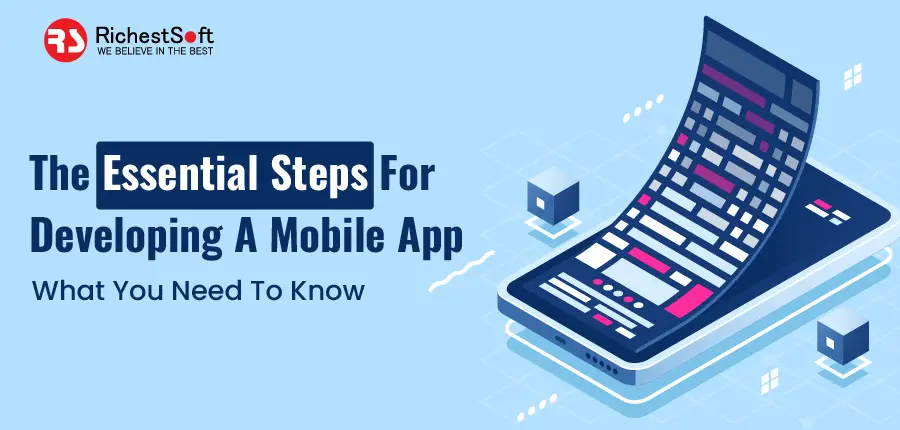Developing an app for mobile devices is a complicated process, and it is crucial to understand the essential steps to successfully creating an app. This blog will take you through the essential steps for developing a mobile app and explain the components necessary for your end product’s success. Read on to find out more!
Introduction
If you are reading this content, you will probably consider developing a mobile app. Congratulations! Developing a mobile app can be a great way to build your brand, reach new customers, and create an additional income stream.
However, before you get started, you need to take a few steps to ensure your success. By the end of this article, you will know what you need to do to create a successful mobile app.
So let us get started!
What are the Essential Steps for Developing a Mobile App?
- Define the problem that your app will solve. What need does it fill?
- Research the competition and find a unique angle for your app.
- Create wireframes or mockups of your app interface and user flow.
- Develop a prototype of your app and test it with users.
- Build the backend infrastructure for your app.
- Design and develop the frontend interface of your app.
- Test, launch, and iterate on your app until it is ready for public release.
Step 1: Ideation and Documentation
The first step in developing a mobile app is ideation or generating ideas for your app. It can be done through brainstorming sessions with your team, looking at competitor apps, or developing a view independently. Once you have a few ideas, it is time to start documenting them. It includes creating wireframes or mockups of your app screens, writing down functionality requirements, and assembling an essential structure for your app. This documentation will help you communicate your vision to developers and designers and ultimately build the app.
Step 2: Design and Prototype
Consider a few things when designing and prototyping your mobile app. First, consider the overall user experience and how you want users to interact with your app. Do you want them to be able to navigate through it quickly, or do you want certain features to stand out?
Once you have a general idea of the user experience, you need to start designing the interface and creating prototypes. It is where you will begin to see your app come to life. You can use various tools to design the interface and create interactive prototypes. After that, testing your prototypes with actual users is essential to get feedback and ensure everything is working as intended.
Designing and prototyping your mobile app can be a fun and creative process. Just keep the user experience in mind and test your prototypes before moving on to development.
Step 3: Frontend Development
Assuming you have a well-designed app and a backend ready to go, the next step is front-end development. It is where the application’s interface and functionality are built. The frontend development process usually includes the following steps:
- Creating wireframes and prototypes
- Designing the user interface
- Programming the app
- Testing the app
- Launching the app
Creating wireframes and prototypes: The first step in front-end development is to create wireframes and prototypes of your app. Wireframes are simplified versions of your app that help you map out its features and user flow. Prototypes are more detailed versions of your wireframes that allow you to test your app’s design and functionality.
Designing the user interface: Once your wireframes and prototypes are complete, it is time to start preparing your app’s user interface (UI). It involves creating all the visual elements that users will see and interact with when using your app. When designing your UI, it is crucial to keep things simple and easy to use – remember, less is more!
Programming the app: Once the UI is designed, it is time to start programming your app. It is where all the behind-the-scenes magic happens! You will need to write code to make your app work as intended.
Testing the app: After programming the app, it is mandatory to test your app thoroughly before releasing it to the public. There are many ways to do this, but one of the most important is to test it on a variety of devices. It includes testing on different operating systems, browsers, and screen sizes.
Launching the app: Launching an app in front-end development can be a daunting task. There are many factors to consider, such as the design of the app, the functionality of the app, and how to get the app in front of potential users. However, with careful planning and execution, launching an app can be a successful endeavor.
Step 4: Backend Development
Developing the backend for a mobile app can be complex and time-consuming. Here are some key points to know before you start:
- Define the app’s data model: This will determine how the app’s data is structured and how it will be stored.
- Choose a backend platform: Many options are available, such as Parse, AWS Mobile Hub, and Firebase. Decide which one best meets your needs.
- Implement the server-side logic, including everything from user authentication to database interactions.
- Test, test, test!: Thoroughly test the backend before launch to ensure it is stable and scalable.
Step 5: Testing and Quality Assurance
After you have built your app, testing it thoroughly before releasing it to the public is essential. It is where quality assurance comes in. QA is the process of ensuring that your app is free of bugs and errors and meets all the requirements you have set out.
There are several methods you may use to test your app. The first is to use an emulator, a program that simulates how your app will run on an actual device. Emulators help test basic functionality, but they can not give you an accurate picture of how your app will perform on existing hardware.
The second way to test your app is to use real devices. It is the most effective test method because you can see exactly how your app will behave on different types of devices. If you can, test on as many devices as possible.
Finally, beta testing is a great way to get feedback from real users before you launch your app. Beta testers can help you catch any last-minute bugs or errors and give you valuable feedback about the overall experience of using your app.
Step 6: Launch and Maintenance
Once your app is live, tracking how users interact with it and making changes as per is vital. It is known as app maintenance.
There are a few key things you need to do to keep your app running smoothly:
- Monitor app usage data and user feedback. It can assist you in determining any areas that require development.
- Update your app frequently with new features and security updates. It will keep users engaged and coming back for more.
- Promote your app through marketing and advertising campaigns. It will help increase its visibility and reach more potential users.
- Provide customer support in case users have any problems or questions. It will ensure that they have a positive experience using your app.
Understand Your Target Audience
The success of your app depends on knowing and defining your company’s app marketing strategy in addition to the precise definition of your app’s goal. Are you creating a mobile app for internal users or users outside the company? What advantages does your software provide for users? Users may be unable to see your mobile app’s benefits if you can not clearly explain how it will help them. Mobile applications that do not offer users any value or advantages are swiftly dropped.
You must comprehend your target to ensure that your mobile app adds value for users. For most companies, their current or potential clients would be the perfect audience. You can accurately determine what your target audience wants, needs, and common issues they are trying to solve by conducting audience research and analysis.
If you do not correctly define your target market, your business may create an app that no one uses. Spending money on developing apps without first conducting audience research is a waste.
Understand Your Competitors
Competition analysis is a crucial and beneficial step in the development of mobile applications. Competitor analysis can offer essential information that will significantly help your project to develop mobile applications. Your company benefits from researching your competitors’ mobile app offer because:
Ø Define its target audience.
Ø Verify the app’s most essential features and functions.
Ø Find out the demand for its app idea on the market.
Ø Use components of its mobile app to make money.
Ø Do not make the same mistakes that other businesses do.
By using competitor analysis, your business can find and close service gaps. Your mobile app must provide users with value if you want it to be successful. The simplest method to add value for users is to give them something they do not already have. You cannot effectively assess the present market or predict demand for your app idea if you do not take the time to comprehend your competition.
How Much Does App Development Cost?
For obvious reasons, this is the most often-asked question. When committing to invest in development, every firm wants to have a comprehensive awareness of the costs involved. However, the price of developing an app varies. A gallon of milk costs roughly the same everywhere, but app development is not like that. Your app development project’s specifics will influence the price, but sure developers may charge you more for their labor and time than others.
The fact is that creating apps is not a cheap service. As we have already discussed in this piece, application development is a process that demands close attention to detail and extensive planning. Also, a firm might benefit significantly from having well-designed mobile and online apps. Also, app developers are highly qualified technological experts. Thus, these services may require a significant financial commitment.
Without knowing the specifics of your app idea, it would be hard to estimate the cost of app development, but we can discuss the main aspects that influence the price.
FAQ
Q1: What are the key steps involved in developing a mobile app?
Ans: Developing a mobile app involves a few key steps:
- Identifying your target audience.
- Defining the features you want to include.
- Determining the right platform for your app.
- Designing the user interface and user experience.
- Coding the app and ensuring its security.
- Testing it.
- Releasing it to the market.
After releasing your app, you must stay on top of updates and monitor how users engage with it. With proper planning and execution, you can ensure that your mobile app is successful.
Q2: What factors should we consider when choosing a platform or programming language for our mobile app development?
Ans: Several key factors should be considered when selecting a platform or programming language for mobile app development. Firstly, your target audience – different operating systems offer different features and user experiences, so it is important to consider which platform they prefer. Additionally, you should think about scalability and performance – different platforms can have varying levels of complexity depending on the type of application you are creating. Finally, considering budget and time restraints is essential when making development decisions. Ultimately, the best choice for your project will depend on various factors.
Q3: How can we ensure our mobile app is user-friendly and engaging for our target audience?
Ans: Start by understanding your target audience. Get to know habits and preferences, such as the type of devices they use, what features they value the most, and how they interact with mobile apps. Once these insights are collected, you can create a user-friendly experience that meets their needs. Additionally, implementing features like push notifications or in-app rewards will help to keep users engaged with your app. You can also use A/B testing and user feedback loops to continually improve the usability of your mobile app.
Conclusion
Developing a mobile app can be an exciting and rewarding process, but it is not something to take lightly. However, with the proper guidance and steps, you can achieve your goal of creating a fantastic app that stands out from the competition. To ensure success, take it one step at a time and follow best practices for each stage of development. With patience and dedication, you will be well on your way to developing a terrific mobile application.







Leave a Reply